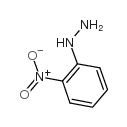High-performance liquid chromatographic analyses of hydroxymonocarboxylic acids and dicarboxylic acids in urine as their 2-nitrophenylhydrazides.
H Miwa, M Yamamoto, T Asano
Index: Anal. Biochem. 185(1) , 17-23, (1990)
Full Text: HTML
Abstract
Both hydroxymonocarboxylic acids and dicarboxylic acids in urine were converted into their 2-nitrophenylhydrazides without lengthy and cumbersome sample workup and were separated from each other by two-step extraction with diethyl ether at different pH values. HPLC analysis of each acid group was achieved isocratically within 30 min. By the use of a visible-range detector (400 nm) the detection limits ranged from 1 to 2 pmol and from 2 to 5 pmol per injection for the hydroxymonocarboxylic acids and dicarboxylic acids, respectively. The analytical results showed good recovery and reproducibility. Analysis profiles of the two acid groups in normal and diabetic subjects could be performed with 200 microliters of urine. The present method is superior over previously published methods because of its great simplicity and its time-, cost-, and labor-saving nature.
Related Compounds
| Structure | Name/CAS No. | Molecular Formula | Articles |
|---|---|---|---|
 |
2-Nitrophenylhydrazine
CAS:3034-19-3 |
C6H7N3O2 |
|
Liquid chromatographic determination of free and total fatty...
[J. Chromatogr. A. 523 , 235-46, (1990)] |
|
Determination of methyl ethyl ketone in human urine after de...
[J. Chromatogr. A. 489(2) , 419-24, (1989)] |
|
On-line determination of carboxylic acids, aldehydes and ket...
2004-03-26 [J. Chromatogr. A. 1031(1-2) , 35-50, (2004)] |
|
High-performance liquid chromatographic analysis of fatty ac...
[J. Chromatogr. A. 568(1) , 25-34, (1991)] |
|
Antigenic determinants of Staphylococcus aureus type 5 and t...
1998-10-01 [Infect. Immun. 66(10) , 4588-92, (1998)] |